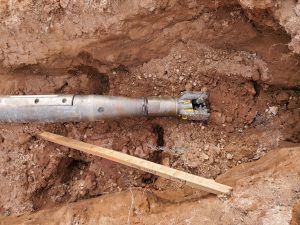Caliche is Hard for HDD
Most people think of shallow soil horizons as being unconsolidated silts and clays, however in some parts of the western US, caliche provides quite the counterexample. At a recent project in Texas, Ellingson-DTD crews faced the caliche challenge to install conveyance lines for environmental remediation wells.
Drilling in caliche can be difficult for any type of drilling contractor, but the HDD method faces some unique difficulties.
Caliche Isn’t Really Jettable
Directional drilling relies on an asymmetry in the bit assembly which steers by deflecting to one direction or another. In soft sediments, this deflection is accomplished by jetting with the hydraulic force of the drilling fluid and pushing on the bit assembly without rotation. Of course, consolidated sediments like bedrock or caliche are not readily jettable, so the bit needs to be constantly rotating.

A dual-rod directional drilling assembly ideal for challenging geological conditions like caliche
In order to maintain the necessary angle of deflection while still rotating the bit, hard rock drilling requires special tooling. That means either a mud-motor or a dual-rod assembly.
Getting Out of Caliche is Hard
During directional drilling, curves in the bore profile attenuate the downforce from the rig. This reduces the amount of energy effectively applied to the bit face. This issue can become a significant problem while building an exit angle in layers of caliche with varying hardness/thickness.
Often the resistive layers will cause the bit to “bounce” along the caliche lens without building the proper exit angle. This challenge can be especially difficult if a small exit area necessitates a high degree of precision in the bore path.
Conveyance Lines Under a Frontage Road
A recent project in Texas involved the trenchless installation of conveyance lines to connect injection/extraction wells to a treatment system. The vertical wellheads sat smack in the middle of the median between the feeder road and a major interstate. From a safety perspective, it made more sense to set up the rig at the treatment system rather than between the two high traffic roadways.
But that meant hitting a relatively small exit window, and the crew knew they would encounter caliche in the subsurface.
Ellingson-DTD mobilized our DitchWitch 30AT (All Terrain) rig, which uses a dual-rod drilling assembly for consolidated soil conditions.
Although the geology proved to be as challenging as expected, the crew managed to complete a series of three (3) borings to 400, 189 and 650ft respectively. The borings connected three different wellheads in the median to the central treatment compound. Each boring included a bundle of several different conveyance lines, including both water conveyance lines for the extraction/injection wells as well as electrical conduit to run the wellhead infrastructure.
Tags: bundled conduit, caliche, directional borings, environmental conveyance lines, environmental HDD, HDD in caliche, road crossing, trenchless conveyance lines. directional drilling